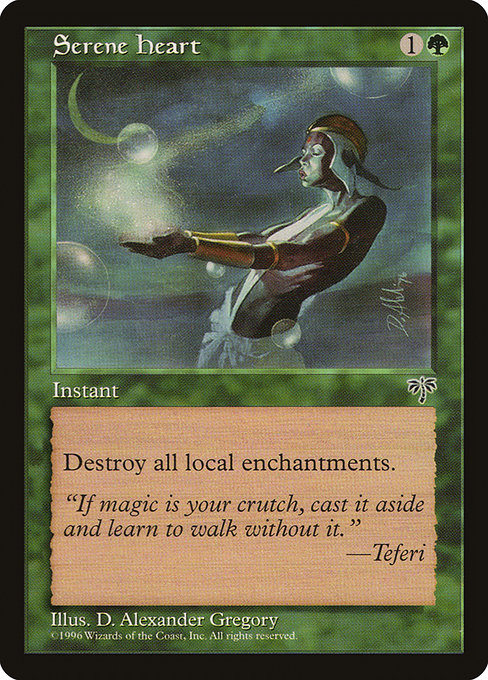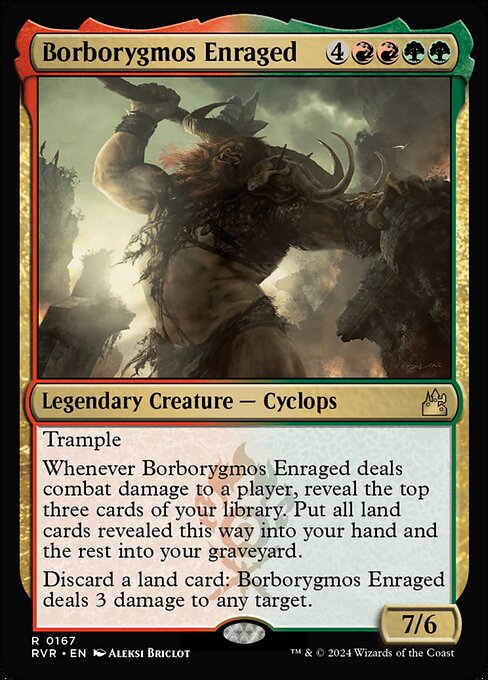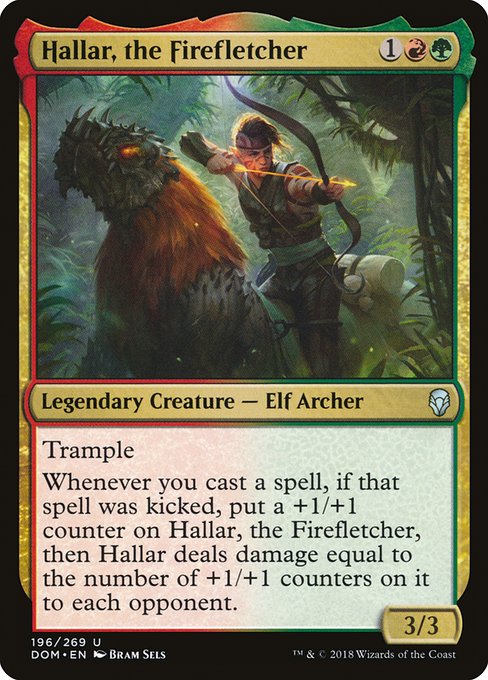Welcome, Commander players! This primer is on the basics of playing Gruul in Commander, and is part of a ten-part series that covers all of Magic’s two-color pairs. In this series, we go through the strengths and weaknesses of each color pair, as well as common play styles. You can read our other primers so far: Simic, Dimir, Azorius, Selesnya, Boros, Izzet, Golgari, Rakdos.
The Gruul Clans represent wild, untamed freedom. They blend the fiery passion of Red with the vigor of Green. Together, they make for hard-hitting decks that look to overrun their opponents by sheer force. There are a variety of different directions that these can be built, some stronger than others. Wizards of the Coast has brought a host of new Commanders to Gruul, but is it enough to help it stand out in the crowd?
Strengths
Aggressive Creatures: These decks are the place to play beefy, aggressive creatures. These are the kinds of things that don’t care about the tokens that Bitterblossom puts out, or the Solemn Simulacrum that your opponent will block with. Gruul wants to play Savage Ventmaw or Quartzwood Crasher, and turn them sideways until the job is done. Few color pairs come close to the raw power that Red and Green creatures put up when they work together. This is bolstered by the fact that both colors can ramp effectively, allowing us to get Drakuseth, Maw of Flames or Bogardan Hellkite out earlier in the game.

Gruul has plenty of ways to support creature decks, such as Rhythm of the WIld, Garruk’s Uprising, and Guardian Project. With three opponents to handle, these enchantments help keep our creatures from going to waste. We also have support creatures to ensure that the bigger ones land, such as Vexing Shusher, Prowling Serpopard, and Gaea’s Herald.
Ramp: These days, it goes without saying that Green is good at ramp. Three Visits was recently reprinted, joining the likes of Rampant Growth, Farseek, and Nature’s Lore for two mana. There are long standing staples like Cultivate and Wood Elves, and many better versions of Explosive Vegetation. There are so many effects that put physical lands into play that one could make the case that you don’t need mana rocks like Talisman of Impulse or Gruul Signet. Sure, other colors can play Sol Ring and Izzet Signet on turn one, but that’s more of an exception and not the rule.

Red has brought a variety of new tools in recent years, such as Dockside Extortionist, Curse of Opulence, and Neheb, the Eternal. Additionally, a recent reprint of Mana Echoes means that tribal decks get powerful ramp at a better price. While these effects aren’t as methodical as those in Green, they offer explosive power for when the game gets busted wide open. That helps Gruul keep up with cards like Smothering Tithe or Crypt Ghast. If you’re willing to risk it, Overabundance gets a game going, and going fast.
Through a thoughtful balance of these effects, Gruul decks have no shortage of options. Their mana resources can get as big as the beefy creatures they churn out.

Board Wipes: Gruul is fantastic at blowing things up en masse, namely for noncreature permanents. Bane of Progress, Vandalblast, and Shatterstorm are three standbys in this department. While Red brings most of the artifact destruction, Green can handle enchantments very easily. They can play cards like Back to Nature or Serene Heart, crippling an Enchantress deck for little investment. In a format with a lot of noncreature permanents, such as mana rocks, this gives Gruul a good way of resetting the board.
They’re a bit more challenged in handling creatures, though. Nevertheless, Gruul decks work with damaged-based sweepers like Blasphemous Act, Chain Reaction, or even Firespout. Red does most of the heavy lifting here, since Green cards like Whirlwind are too narrow for widespread play.

Card Draw: For most of Magic’s history, Red and Green have been lackluster at drawing cards. However, they’ve gone a full 180 in recent years, and have plenty of options to choose from. This is largely in part to the push we’ve seen on Green, giving it access to all sorts of effects it used to struggle at. Most of the card draw options in Gruul come from the past few years, such as Guardian Project, The Great Henge, and Valakut Exploration. Green cares about having sizable creatures, and Red grants “impulsive” card draw effects that last until the end of turn. With both colors bringing aggressive creatures to the table, the effects pair nicely.
Weaknesses
Format Identity and Depth of Commander Choices: These two topics go hand-in-hand, so it makes sense to talk about them together. We’re looking at a sort of “chicken or the egg” scenario, because both problems influence the other.
If you look at the most popular commanders for Gruul, there are some telling signs. There are a variety of archetypes to choose from, but they are carried on the shoulders of one or two commanders. The top theme for Gruul is Lands, but the list of viable options is short. This continues on down the line for other Gruul archetypes, like +1/+1 Counters or Tokens. On the contrary, you can look at the likes of Dimir Mill, Simic +1/+1 Counters, and Orzhov Lifegain to see what it looks like when there’s a concentrated effort to give those themes a home.
There are other areas of Gruul that were born from the existence of a leading commander. For instance, Thromok, the Insatiable, Borborygmos Enraged, and Rosheen Meanderer. These all make for quirky strategies that heavily feature the commander. However, we don’t see many things like these decks, when we venture out into the greater landscape of choices.

This raises a pair of conflicting questions. Are there not many choices in Gruul because of the lack in format identity? Or, are the lack of choices causing Gruul to not find a real footing? On one hand, you have Commanders that make up almost an entire archetype by themselves, without many other Gruul alternatives. On the other hand, you have a situation where Gruul goes in a bunch of different directions, but fails to land on and develop a specific archetype.
FIghting for a Spot at the Table: As it stands now, the most popular Gruul themes are swallowed up by other more popular commanders and color combos. For instance, Lands decks are being carried by Third Era “Value Engine” commanders, such as Lord Windgrace, Golos, Tireless Pilgrim, and Tatyova, Benthic Druid. Meanwhile, we’ve established that +1/+1 counters are largely a Simic thing, and Token decks trend towards Selesnya. This can leave Gruul decks out in the lurch, when there are other decks doing what they do, but better.
Common Commanders and Archetypes
Big Creature Aggro: This is arguably the hallmark Gruul archetype. The playstyle is straightforward and concise: ramp a lot, play big creatures, and attack with them. While you can play creatures in any color combination, Gruul blends the best of both worlds for a true beatdown strategy. Green and Red are known for having cost-efficient creatures that also have potent ETB effects; think Dockside Extortionist, Bane of Progress, and Reclamation Sage. Xenagos, God of Revels, Ruric Thar, the Unbowed, and Nikya of the Old Ways are three popular commanders to choose, each with a different way of approaching the same challenge. How effective they are can depend on the local metagame, although Xenagos’ indestructibility makes him a perennial favorite in this category.

This also lends itself to a “Creatures matter, but noncreature spells don’t” theme. From the command zone, Nikya brings prizes, and Ruric Thar brings punishment. I’m curious to see if this gets explored more in coming sets, since it looks like the start of a new direction for Gruul.
Lands: These are typically big mana decks that aim to put a lot of lands into play. They also tend to use and abuse Landfall cards, such as Moraug, Fury of Akoum or Avenger of Zendikar. This is backed up by the usual suite of Green ramp cards, such as Oracle of Mul Daya, Lotus Cobra, and Dryad of the Ilysian Grove. As for commanders, Omnath, Locus of Rage, Phylath, World Sculptor, and Borborygmos Enraged are popular choices. These decks tend to be quiet in the early turns, but then get explosive once they can start putting multiple lands out per turn. If they resolve a Scapeshift, Boundless Realms, or Reshape the Earth, then odds are good that the game is ending very soon. For players that like combo decks, these can provide a similar feeling of “going off” without needing cards like Thassa’s Oracle or Tendrils of Agony.

Tokens: These decks are similar to their Selesnya counterparts, with some key differences. While they aim to go wide with a ton of creatures, their payoffs look different. Selesnya decks play anthems like Cathars’ Crusade and Collective Blessing to grow their ranks. Meanwhile, Gruul token decks like damage-based effects, like Purphorous, God of the Forge, Impact Tremors, and Warstorm Surge. This allows token decks to be more about creating tokens themselves, instead of attacking with them. Since they don’t need to win through combat damage, the play style is nonlinear. Having multiple paths to victory, instead of just one, can keep us coming back to a deck instead of getting bored of it. As for popular token commanders, you could look at Thromok, the Insatiable, Grand Warlord Radha, or Wort, the Raidmother.
Tribal: Werewolves and Dragons and Hydras, oh my! There aren’t many creature types that fall firmly into Gruul, but these three are at the top of the list. Dragons and Hydras fit nicely in the Gruul ethos, since they’re both splashy, high-impact creature types. Atarka, World Render and Rosheen Meanderer head up Dragons and Hydras, respectively.
Meanwhile, Werewolves is still looking for a worthwhile commander. Technically, you can run Ullrich of the Krallenhorde, but he offers zero tribal synergy. When I wrote about the wolf pack back in August, we talked about why Ullrich falls short. I remain optimistic for the upcoming Innistrad set a year from now, confident that it will finally bring us the Werewolf commander we’ve been asking for.

Other Oddities: Scroll through the Gruul page on EDHrec, and you’ll see all sorts of curiosities. We have everything from fight effect decks with Neyith of the Dire Hunt, to “Kicker Matters” with Hallar, the Firefletcher, to +1/+1 Combo with Grumgully, the Generous. Other players are churning out X spells with Rosheen Meanderer, looking to go bigger than anyone else at the table. Finally, some folks just love watching Tahngarth, First Mate chaotically rack up commander damage. There’s a lot to find in Gruul, if you’re willing to get into the weeds.
Final Take
Gruul is a powerful color pair to play, but it needs to find more of a clear identity in the format. It can be open-ended for players that want more of a blank canvas to create with, but others might want more direction in their strategy. Since both Green and Red have gone through drastic changes in the past few years, these growing pains may be subtly showing up in their legendary creatures. Time heals all, though, so I’m confident that Gruul will get a more defined place in Commander. It’s getting a lot of market share gobbled up by Simic and Jund decks, which presents a unique challenge for Wizards of the Coast. In the meantime, we’ll keep happily smashing things.
Travis is a Virginia-based player and writer, who has been turning things sideways since Starter 1999. He primarily plays Commander, Pauper, and Legacy, and has a passion for introducing new players to the game. When he isn’t making people pay the Thalia tax, he can be found mountain biking or playing the guitar. You can follow his exploits here on Twitter and Instagram.

